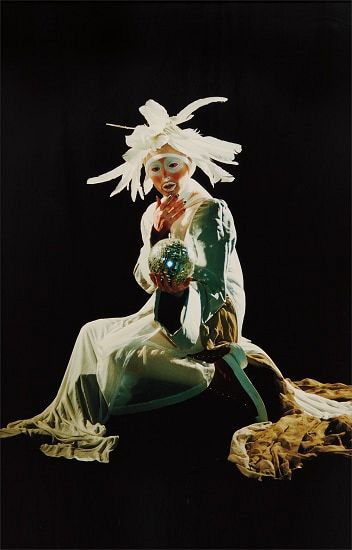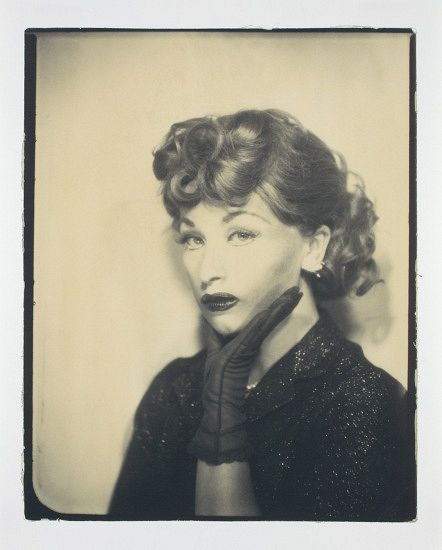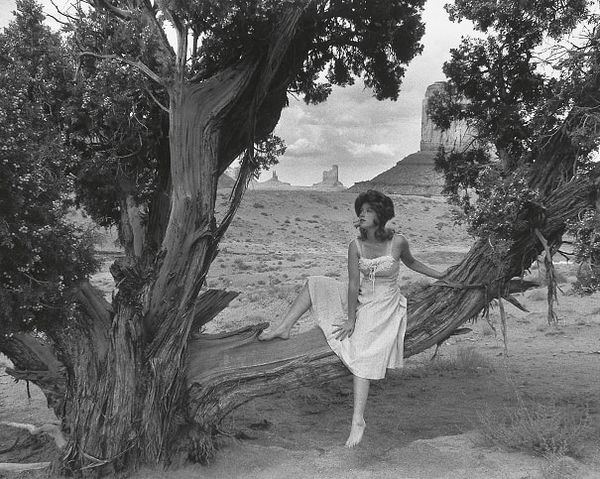Cindy Sherman, Untitled Film Still #43, 1979. Sold for $275,000. 20th Century & Contemporary Art Day Sale.
Cindy Sherman’s first Instagram post is from the Kill Bill restaurant in Tokyo. Angled and poorly lit, the image shows diners’ footwear lined up against the wood slats elevating the shoe-less seating above. She seems excited to share it. The following posts have a similar aesthetic, sometimes they have captions, sometimes they don’t; when they do, they’re descriptive (“Seaweed harvesting boats,” “Mt Fuji from air”). In other words: the photos would seem to belong to someone who is enjoying their trip to Japan, not necessarily one of the most important photographers of the last century.
It is around 2017, when Sherman began experimenting with facetuning apps, that her Self—the one you expect—begins to seep in. These posts, which show her face pinced, compressed, expanded, and made-up, evoke her widely, wildly acclaimed oeuvre in which she remolds her body into the archetypes and caricatures that, while fictitious, expose the grotesquely entrenched imagination of the female body. Both within the context of her own oeuvre and the infamous selfie-forward app, her Instagram radiates a kind of existential ennui about who we are when other people are watching.
Sherman’s own work has depended on setup photography, performing the roles in which women have been typecast, on camera and in life. It began quite organically—after graduating from SUNY Buffalo in the 1970s, she and Robert Longo, her boyfriend at the time, relocated to New York City. Later, she recalled, “I was really shocked at how I was treated just walking down the street.” So used clothing and makeup as an armor to get around the city, inventing characters that she then started to photograph.
This brings us to “Untitled Film Stills”—the series that has become inextricable from Sherman’s reputation. In the series, Sherman cast herself in cinematic clichés, from the ingénue to the siren, and left them floating in an evocative, but ambiguous “untitled” world. But this was only the start—in the years since, Sherman has chameleoned into Mrs. Claus, a suntanned vacationer in a bucket hat, a Renaissance theologian, and creepy clowns that express an entire psychology through the way she juts her chin, raises an eyebrow, or holds a paper fan. Sometimes she does not appear or makes only a cameo; the “Disaster” series from 1987-1989 mostly comprises stomach-churning food discards, fake body parts, and bodily fluids.

Cindy Sherman, Untitled #296, 1994. Sold for $325,000. Photographs New York.
Although, one could argue that Sherman never appears—at least not as herself. Despite being the actor, Sherman’s own personality is not on view, completely driven away from the frame. Instead, her photographs construct the Self, not from the inside out—the person we project and perform—but from the outside in—the way the recesses of our mind and our society have shaped the way we look at each other. Sherman is notoriously withholding about her theoretical stance, but, as she explained in an interview, “What I’m against is how your mind is fucked with about what you should be, instead of what you are.”
On Instagram, though, Sherman relies more on her actual Self as the basis of the work, as she tweaks her nose here or her dismembered head floats amid an untraceable landscape. These women are knowable and unknowable, relying on the subliminal suspension of disbelief that Instagram requires. They are an Instagram filter amplified beyond recognition—instead of faux-dorky animal ears and cutesy freckles, here’s a face superimposed on a face superimposed on another face. If it wasn’t clear, Sherman finds the traditional selfie unstomachable. As she recently commented, selfies are “people trying to look better for attention’s sake. There is something desperate about that—wanting people to pat you on the head and tell you that you are fantastic or beautiful.”

Cindy Sherman, Untitled (Lucille Ball), 1975/2001. Sold for $16,250. Editions New York.
But what is most unsettling about Sherman’s Instagram is how the whole grid feels like a digital installation piece. When she posts something “normal,” pictures of a museum exhibition or a family photo, you suddenly find yourself questioning whether that image depicts reality—where’s she hiding? Where’s the trick? And suddenly you remember that Cindy Sherman inhabits your world too, that she can get very excited about the Kill Bill restaurant, from time to time. It’s a reminder, probably, that while artists are just like us!, the Instagram Self is not.
Discover More from Cindy Sherman >

Recommended Reading
Curator Erica Warren on What's Next for the Art Institute of Chicago >
Specialist Picks: Unlikely Pairings, From Dürer to Richter >
